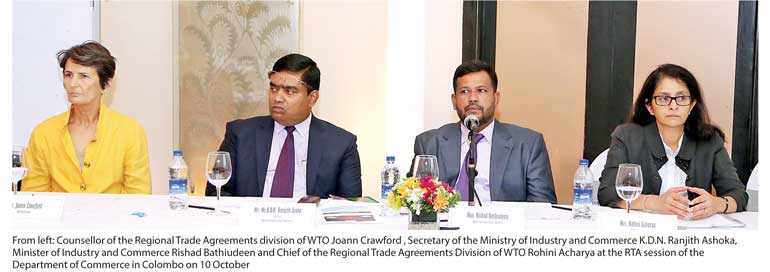Thursday Apr 03, 2025
Thursday Apr 03, 2025
Wednesday, 11 October 2017 00:00 - - {{hitsCtrl.values.hits}}

No less than two-thirds of annual imports to Sri Lanka will enter the country duty free when FTAs with China and Singapore are wrapped up, said a visiting top official from WTO in Colombo yesterday.
“At present over half of Sri Lanka’s imports at 51% are from MFN sources at zero import duty. Assuming both China and Singapore FTAs are successfully formulated, and with zero duty rates, the total volume of duty free imports to Sri Lanka will be 75% of the country’s annual imports,” said the Chief of the Regional Trade Agreements Division of WTO Dr. Rohini Acharya yesterday in Colombo.
Acharya, joined by the visiting WTO Counsellor Jo- Ann Crawford, was addressing the launch event of the National Seminar on WTO and Regional Trade Agreements organised by the Department of Commerce at the Taj Hotel in Colombo.
“In that, the volume of duty free imports annually entering Sri Lanka will go up to 75% from the present 51%, bringing significant advantages to the economy such as low-cost products in the market and low-cost raw materials for export industries. The two new FTAs can bring an additional 24%, totalling it to 75%,” said Acharya.
“Beware of how you define RTAs – a real RTA should be reciprocal; unilateral agreements such as the GSP are not two-way. We are talking of such two-way (reciprocal) programs as the India-Sri Lanka FTA and Pakistan-Sri Lanka FTA.”
Minister of Industry and Commerce Rishad Bathiudeen, addressing the session, said that Sri Lanka was the first South Asian nation to introduce market-based economic reforms.
“The multilateral trading system and regional trade agreements have a long history of existing together. Throughout the history of the GATT and with the creation of the WTO there are examples of RTAs and the multilateral system using ideas from each other as well as many other international treaties and building further on them. From an average of three RTAs notified per year during the GATT period, the number has risen to 25 during the WTO times. Moreover, RTAs today cover a wide range of WTO members whether they are developed, developing or least developed. The goal of modern RTAs is to provide preferential market access and also increasingly to go behind the borders to address other potential barriers to trade.”
Secretary of the Ministry of Industry and Commerce K.D.N. Ranjith Ashoka said that it was vital to resolve trade issues but they should not be deterred from working on RTAs.
“We are presently working towards China and Singapore FTAs. The FTA work is proceeding with much care so that local stakeholders are protected. Sri Lanka’s hub positioning is key. They call it Open Skies, but the open ocean routes are even more important for our trade development. For example, we handle 30% of Indian container trans-shipments.”
The two-day workshop by the Department of Commerce concludes on 11 October and includes top officials and participants from the Central Bank, the Treasury, the BOI, reps from five chambers and Lankan corporates in exports.
Acharya has a PhD in Economics and joined the WTO’s Trade Policies Review Division in 1996, becoming Chief of its Regional Trade Agreements Section in January 2007. Previously she worked as Senior Research Fellow at the International Economics Programme of the Royal Institute of International Affairs (Chatham House) in London. Jo- Ann Crwford (MA in Economics) is the author of a number of studies on RTAs and has also worked on several trade policy reviews, including that of the Southern African Customs Union (SACU).
Discover Kapruka, the leading online shopping platform in Sri Lanka, where you can conveniently send Gifts and Flowers to your loved ones for any event including Valentine ’s Day. Explore a wide range of popular Shopping Categories on Kapruka, including Toys, Groceries, Electronics, Birthday Cakes, Fruits, Chocolates, Flower Bouquets, Clothing, Watches, Lingerie, Gift Sets and Jewellery. Also if you’re interested in selling with Kapruka, Partner Central by Kapruka is the best solution to start with. Moreover, through Kapruka Global Shop, you can also enjoy the convenience of purchasing products from renowned platforms like Amazon and eBay and have them delivered to Sri Lanka.
Discover Kapruka, the leading online shopping platform in Sri Lanka, where you can conveniently send Gifts and Flowers to your loved ones for any event including Valentine ’s Day. Explore a wide range of popular Shopping Categories on Kapruka, including Toys, Groceries, Electronics, Birthday Cakes, Fruits, Chocolates, Flower Bouquets, Clothing, Watches, Lingerie, Gift Sets and Jewellery. Also if you’re interested in selling with Kapruka, Partner Central by Kapruka is the best solution to start with. Moreover, through Kapruka Global Shop, you can also enjoy the convenience of purchasing products from renowned platforms like Amazon and eBay and have them delivered to Sri Lanka.